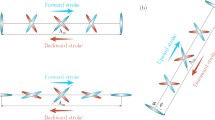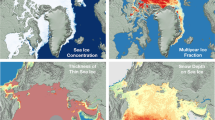Abstract
Small-scale turbulent fluctuations of temperature are known to affect the propagation of both electromagnetic and acoustic waves. Within the inertial-subrange scale, where the turbulence is locally homogeneous and isotropic, these temperature perturbations can be described, in a statistical sense, using the structure-function parameter for temperature, \(C_{T}^2\). Here we investigate different methods of evaluating \(C_{T}^2\), using data from a numerical large-eddy simulation together with atmospheric observations collected by an unmanned aerial system and a sodar. An example case using data from a late afternoon unmanned aerial system flight on April 24 2013 and corresponding large-eddy simulation data is presented and discussed.










Similar content being viewed by others
References
Asimakopoulos DN, Cole RS, Caughey SJ, Crease BA (1976) A quantitative comparison between acoustic sounder returns and the direct measurement of atmospheric temperature fluctuations. Boundary-Layer Meteorol 19:137–147
Balsley BB (2008) The cires tethered lifting sysytem: a survey of the system, past results, and future capabilities. Acta Geophys 56(1):21–57
Bonin TA, Chilson PB, Zielke B, Fedorovich E (2012) Observations of early evening boundary layer transitions using a small unmanned aerial system. Boundary-Layer Meteorol 2:1–14. doi:10.1007/s10546-012-9760-3
Bonin TA, Chilson PB, Zielke BS, Klein PM, Leeman JR (2013) Comparison and application of wind retrieval algorithms for small unmanned aerial systems. Geosci Instrum Method Data Syst 2:177–187
Bonin TA, Goines D, Scott A, Wainwright CE, Gibbs JA, Chilson PB (2015) Measuring structure function parameters with a small unmanned aerial system. Boundary-Layer Meteorol, (in press)
Cheinet S, Cumin P (2011) Local structure parameters of temperature and humidity in the entrainment-drying convective boundary layer: a large-eddy simulation analysis. J Appl Meteorol Climatol 50(2):472–481
Cheinet S, Siebesma AP (2009) Variability of local structure parameters in the convective boundary layer. J Atmos Sci 66(4):1002–1017
Deardorff JW (1980) Stratocumulus-capped mixed layer derived from a three-dimensional model. Boundary-Layer Meteorol 18:495–527
Fedorovich E, Nieuwstadt FTM, Kaiser R (2001) Numerical and laboratory study of horizontally evolving convective boundary layer. Part I: transition regimes and development of the mixed layer. J Atmos Sci 58:70–86
Fedorovich E, Conzemius R, Esau I, Chow FK, Lewellen D, Moeng CH, Pino D, Sullivan P, de Arellano JVG (2004a) Entrainment into sheared convective boundary layers as predicted by different large eddy simulation codes. In: Preprints, 16th Symposium on boundary layers and turbulence. American Meteorological Society, 9–13 August, Portland, Maine, USA, pp CD-ROM, P4.7
Fedorovich E, Conzemius R, Mironov D (2004b) Convective entrainment into a shear-free, linearly stratified atmosphere: bulk models reevaluated through large eddy simulations. J Atmos Sci 61:281–295
Frehlich R (1992) Laser scintillation measurements of the temperature spectrum in the atmospheric surface layer. J Atmos Sci 49(16):1494–1509
Gibbs J, Fedorovich E (2014) Comparison of convective boundary layer velocity spectra retrieved from large eddy simulation and weather research and forecasting model data. J Appl Meteorol Climatol 53(2):377–394
Gibbs JA, Fedorovich E, van Eijk AMJ (2011) Evaluating weather research and forecasting (WRF) model predictions of turbulent flow parameters in a dry convective boundary layer. J Appl Meteorol Climatol 50(12):2429–2444
Gur’yanov AE, Kallistratova MA, Martvel FE, Pequr MS, Petenko IV, Time NS (1987) Comparision of sodar and microfluctuation measurements of the temperature structure parameter in mountainous terrain. Atmos Ocean Phys 23(9):685–691
Gur’yanov AE, Kallistratova MA, Kutyrev AS, Petenko IV, Shcheglov PV, Tokovinin AA (1992) The contribution of the lower atmospheric layers to the seeing at some mountain observatories. Astron Astrophys 262:373–381
Holland GJ, adn JA, Curry PJW, Tyrell G, Gauntlett D, Brett G, Becker J, Hoag R, Vaglienti W (2001) The aerosonde robotic aircraft: a new paradigm for environmental observations. Bull Am Meteorol Soc 82:889–901
ISO9613-1 S Geneva (1993) Acoustics—attenuation of sound during propagation outdoors—part 1: calculation of the absorption of sound by the atmosphere. ISO9613-1:1993(E)
Kaimal JC, Businger JA (1963) A continuous wave sonic anemometer-thermometer. J Appl Meteorol 2:156–164
Kumar MS, Anandan VK, Kesarkar A, Narasimha PN (2011) Doppler sodar observations of the temperature structure parameter during moonsoon season over a tropical rural station, Gadanki. J Earth Syst Sci 120(1):65–72
Kunkel KE, Walters DL, Ely GA (1981) Behavior of the temperature structure parameter in a desert basin. J Appl Meteorol 20(2):130–136
Little CG (1969) Acoustic methods for the remote probing of the lower atmosphere. Proc IEEE 57:571–578
Maronga B, Moene AF, van Dinther D, Raasch S, Bosveld FC, Gioli B (2013) Derivation of structure parameters of temperature and humidity in the convective boundary layer from large eddy simulations and implications for the interpretation of scintillometer observations. Boundary-Layer Meteorol 148(1):1–30
Mesinger F, DiMego G, Kalnay E, Mitchell K, Shafran PC, Ebisuzaki W, Woollen J, Jović D, Rogers E, Berbery EH, Ek MB, Fan Y, Grumbine R, Higgins W, Li H, Lin Y, Manikin G, Parrish D, Shi W (2006) North american regional reanalysis. Bull Am Meteorol Soc 87(3):343–360
Muschinski A, Sullivan PP, Wuertz DB, Hill RJ, Cohn SA, Lenschow DH, Doviak RJ (1999) First synthesis of wind-profiler signals on the basis of large-eddy simulation data. Radio Sci 34(6):1437–1459
Neff WD (1975) Quantitative evaluation of acoustic echoes from the planetary boundary layer. J Atmos Sci 36:1820–1821
Peltier LJ, Wyngaard JC (1995) Structure-function parameters in the convective boundary layer from large-eddy simulation. J Atmos Sci 52(21):3641–3660
Petenko I, Argentini S, Pietroni S, Viola A, Mastrantonio G, Casasanta G, Arisitidi E, Bouchez G, Agabi A, Bondoux E (2014a) Observations of optically active turbulence in the planetary boundary layer by sodar at the Concordia astronomical observatory, Dome C. Antarctica. Astron Astrophys 568:A44
Petenko I, Mastrantonio G, Viola A, Argentini S, Pietroni I (2014b) Some statistics of the temperature structure parameter in the convective boundary layer observed by sodar. Boundary-Layer Meteorol 150(2):215–233
Readings CJ, Butler HE (1972) The measurement of atmospheric turbulence from a captive balloon. Meteorol Mag 101:286–298
Scipión DE, Chilson PB, Fedorovich E, Palmer RD (2008) Evaluation of an LES-based wind profiler simulator for observations of a daytime atmospheric convective boundary layer. J Atmos Ocean Technol 25:1423–1436
Shuqing M, Hongbin C, Gai W, Yi P, Qiang L (2004) A miniature robotic plane meteorological sounding system. Adv Atmos Sci 21(6):890–896
Skamarock WC, Klemp JB, Dudhia J, Gill DO, Barker DM, Wang W, Powers JG (2008) A description of the advanced research WRF version 3. Tech. Rep, NCAR, USA
Spiess T, Bange J, Buschmann M, Vörsmann P (2007) First application of the meteorological Mini-UAV ‘M2AV’. Meteorol Z 16:159–169
Tatarskii VI (1961) Wave propagation in a turbulent medium. McGraw-Hill, New York 285 pp
Tatarskii VI (1971) The effects of the turbulent atmosphere on wave propagation. Kefer Press, Jerusalem 472 pp
Taylor GI (1938) The spectrum of turbulence. Proc R Soc Ser A 164:476–490
Thomson D, Coulter R, Warhaft Z (1978) Simulataneous measurements of turbulence in the lower atmosphere using sodar and aircraft. J Appl Meteorol 17:723–734
Travouillon T, Ashley MCB, Burton MG, Storey JWV, Loewenstein RF (2003) Atmospheric turbulence at the South Pole and its implications for astronomy. Astron Astrophys 400:1163–1172
Tunick A (2005) Toward increasing the accuracy and realism of future optical turbulence calculations. Meteorol Atmos Phys 90:159–164
van den Kroonenberg A, Martin T, Buschmann M, Bange J, Vörsmann P (2008) Measuring the wind vector using the Autonomous Mini Aerial Vehicle M2AV. J Atmos Ocean Technol 25:1969–1982
van den Kroonenberg AC, Martin S, Beyrich F, Bange J (2012) Spatially-averaged temperature structure parameter over a heterogeneous surface measured by an Unmanned Aerial Vehicle. Boundary-Layer Meteorol 142:55–77
Weill A, Klapisz C, Strauss B, Baudin F, Jaupart C, Grunderbeeck PV, Goutorbe JP (1980) Measuring heat flux and structure functions of temperature fluctuations with an acoustic doppler sodar. J Appl Meteorol 19:199–205
Wilson C, Fedorovich E (2012) Direct evaluation of refractive-index structure functions from large-eddy simulation output for atmospheric convective boundary layers. Acta Geophys 60(5):1474–1492
Wood CR, Kouznetsov RD, Gierens R, Nordbo A, Järvi L, Kallistratova MA, Kukkonen J (2013) On the temperature structure parameter and sensible heat flux over Helsinki from sonic anemometry and scintillometry. J Atmos Oceanic Technol 30(8):1604–1615
Wyngaard JC, Izumi YSA, Collins J (1971) Behavior of the refractive-index-structure parameter near the ground. J Opt Soc Am 61(12):1646–1650
Acknowledgments
The National Science Foundation (NSF) is acknowledged for the support of the reported study through the Grant ATM-1016153. The authors acknowledge the three anonymous reviewers whose suggestions substantially improved the manuscript.
Author information
Authors and Affiliations
Corresponding author
Rights and permissions
About this article
Cite this article
Wainwright, C.E., Bonin, T.A., Chilson, P.B. et al. Methods for Evaluating the Temperature Structure-Function Parameter Using Unmanned Aerial Systems and Large-Eddy Simulation. Boundary-Layer Meteorol 155, 189–208 (2015). https://doi.org/10.1007/s10546-014-0001-9
Received:
Accepted:
Published:
Issue Date:
DOI: https://doi.org/10.1007/s10546-014-0001-9




